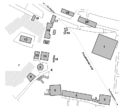Prytaneion
Prytaneion nebo prytaneum bylo sídlo prytanů, což byla obdoba vlády (exekutiva) v demokratických řeckých obcích. Prytaneion stálo na hlavním náměstí (agora, forum) a byla to zároveň posvátná budova obce, kde se – podobně jako ve starověké domácnosti – neustále udržoval oheň bohyně Hestie, římské Vesty.
V Athénách
Když Kleisthenés roku 508 př. n. l. reformoval athénský sněm (búlé, ekklésia), nahradil původní čtyři kmeny (fylai) novými deseti a z každého z nich se do sněmu každý rok volilo 50 členů. Funkci prytanů zastávalo vždy pět z nich, a to po desetinu roku, takže se v průběhu roku vystřídali všichni. V každé době tedy bylo právě 50 prytanů, kteří sídlili v prytaneu a nejméně třetina jich musela být neustále přítomna, proto v prytaneu i spali a dostávali stravu. Spolu s nimi se tam mohli stravovat i „čestní občané“, olympijští vítězové a podobně. Z právě sloužících prytanů se denně losoval předseda (epistatés), který měl obecní pečeť a klíč k pokladnici; tuto funkci nesměl nikdo zastávat dvakrát. Prytanové přijímali cizí vyslance a vedli běžné záležitosti obce, formálně svolávali sněm a epistatés mu předsedal.
Sídlem prytanů v Athénách byla kruhová budova, Tholos, na agoře vedle budovy sněmu (Búletérion), postavená roku 470 př. n. l. na místě starší budovy, zničené Peršany, která patrně sloužila témuž účelu.
Sókratés ve své obhajobě před sněmem nakonec Athéňanům navrhl, aby mu místo odsouzení dali doživotní právo stravovat se v prytaneu jako uznání jeho zásluh o obec.[1]
V jiných městech
Prytaneia stála i v dalších řeckých městech. Poněkud odlišnou funkci mělo prytaneion v Olympii: žili zde chrámoví kněží a úředníci a konaly se zde oslavy pro vítěze her. I olympijské prytaneion ale mělo ohniště bohyně Hestie.
Odkazy
Reference
- ↑ Platón, Obrana Sókratova.
Související články
Externí odkazy
 Obrázky, zvuky či videa k tématu Prytaneion na Wikimedia Commons
Obrázky, zvuky či videa k tématu Prytaneion na Wikimedia Commons - (anglicky)
- Stránka o vykopávkách na agoře v Athénách s obrázkem místa, kde stával Tholos
Média použitá na této stránce
Autor: User:Madmedea, key corrected by User:LlywelynII, Licence: CC BY-SA 2.0
Plan of the ancient agora of Athens c. 5th century BC.
Key
- 01 Square Peristyle, probably used as a courthouse & surrounded by vendors. Built early 4th c. BC, demolished c. 150 BC.
- 02 Mint, used for Athens's bronze coinage. Built c. 400 BC, destroyed c. 1st century.
- 03 SE Fountainhouse, misidentified by Pausenias as the Nine-Spouted Fountain (Enneakrounos). Built c. 525 BC.
- 04 South Stoa I. Built c. 425 BC, dismantled mid-2nd c. BC.
- 05 Aiakeion, dedicated to the Aeginan hero Aiakos, used as a granary & for the display of legal decisions. Formerly misidentified as the Heliaia. Built early 5th c. BC by order of the Pythia of Delphi.
- 06 Strategeion, dedicated to the hero Strategos, used as the meeting house of Athens's 10 generals (strategoi). Built mid-5th c. BC.
- 07 Stone benches of Agora Hill (Kolonos Agoraios). Built late 5th c. BC.
- 08 Tholos. Also known as the Skias from its supposed resemblance to a straw hat. Also known as the Prytanikon or Prytaneion as the home of the Prytany. Built c. 470 BC.
- 09 Boundary stone, marking one entrance to the agora. Erected c. 500 BC.
- 10 Monument of the Eponymous Heroes, the namesakes of the Athenian democracy's 10 tribes, chosen by the Pythia of Delphi. Present structure built late 4th c. BC.
- 11 Metroon, the Old Bouleuterion, dedicated to Cybele in propitiation after the Plague of Pericles was attributed to the murder of one of her missionary priests. Present structure built mid-2nd c. BC.
- 12 New Bouleuterion. Built late 5th c. BC.
- 13 Hephaistion or Theseion, the temple of Hephaestus & Athena the Worker (Athena Ergane), decorated with events in the lives of Hercules & Theseus. Built late 5th c. BC.
- 14 Temple of Fatherly Apollo (Apollo Patroos), honoring his siring of Ion, eponymous forefather of the Ionian Greeks. Built late 4th c. BC.
- 15 Stoa of Free Zeus (Zeus Eleutherios), honoring his help in defeating the Persians at Plataia & decorated with the shields of Athenians fallen in battle. Built late 5th c. BC.
- 16 Altar of the Twelve Gods, sanctuary. Built early 6th c. BC, dedicated 521 BC.
- 17 Royal Stoa (Stoa Basileios), seat of the royal archon (archon basileus), public copies of the city's laws, & the oath stone used to swear in new officials. Built c. 500 BC.
- 18 Temple of Heavenly Aphrodite (Aphrodite Urania). Built late 6th c. BC.
- 19 The Painted Stoa (Stoa Poikile), depicting Athenian victories in paintings & captured arms. Built early 5th c. BC.
- 20 A former mistaken location of the Painted Stoa used when 19 was mistakenly assumed to be the Stoa of the Herms.



